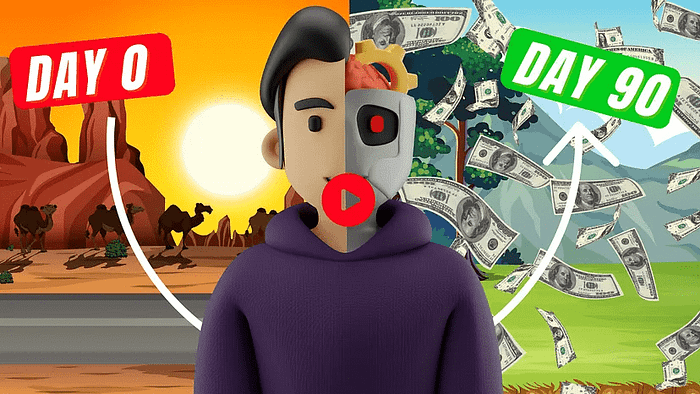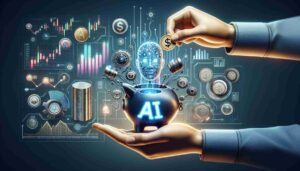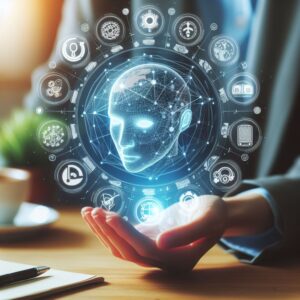AI Revolution Unveiled: America’s Bold Leap into a $700 Billion Future
Standing in the midst of a technological whirlwind, I can’t help but feel the electric pulse of the AI revolution coursing through our world today. It’s February 24, 2025, and the stakes have never been higher—or more thrilling. Just a few weeks ago, on February 11th, JD Vance, Vice President under President Trump, stepped onto the stage at the Paris AI Summit and delivered a speech that left the global audience buzzing. His words weren’t about caution or fear; they were a clarion call for opportunity. He dismissed the old narrative of “AI safety” that dominated past conferences and instead painted a vivid picture of a future ripe with possibility. To me, it was a moment that crystallized what’s at stake: a $700 billion industry that’s set to redefine human civilization. And here’s the kicker—America is poised to lead it all.
This isn’t just a fleeting trend or a tech buzzword that’ll fade by next year. The AI revolution is the most seismic shift I’ve ever witnessed, dwarfing even the advent of the internet or smartphones. Critics once scoffed at those innovations, calling them fads that’d never stick—boy, were they wrong. Now, they’re making the same mistake with artificial intelligence, underestimating its power to transform everything we know. By 2028, experts predict this industry will balloon to $700 billion, maybe even trillions, outpacing the GDP of oil-rich Saudi Arabia—one of the world’s wealthiest nations. What excites me most? Over half of that investment will flow right into the United States, cementing our role as the epicenter of this global race.
We strongly recommend that you check out our guide on how to take advantage of AI in today’s passive income economy.
Table of Contents
Why America Holds the Winning Hand in the AI Revolution
Picture this: a towering stack of advantages, each layer reinforcing America’s dominance in the AI revolution. I see it as the “full AI stack”—a term that captures our edge in semiconductor design, cutting-edge algorithms, and real-world applications that evolve faster than you can blink. Our engineers craft chips that power the most advanced systems on Earth, while our researchers push boundaries with algorithms that learn and adapt daily. Meanwhile, industries from healthcare to agriculture are already deploying AI in ways that feel straight out of science fiction. But what truly sets us apart isn’t just tech—it’s freedom.
While other nations bog down their innovators with red tape, America lets creativity run wild. I think of countries wrestling with overregulation, trying to cage AI like a wild animal, and it’s clear they’re falling behind. Take China’s DeepSeek release—it’s impressive, sure, but it’s no match for the ecosystem we’ve built. Here, startups and grad students alike can experiment without fear of bureaucratic shackles. That freedom fuels a projected $350 billion-plus investment in U.S. AI by 2028—more than half the global total. It’s not just about money, though; it’s about who gets to steer humanity’s future. And right now, I’d bet every dollar I have on America leading the charge.
AI Doesn’t Replace—It Amplifies
Here’s where the AI revolution flips the script on every tech wave before it—I’m convinced it’s not here to steal jobs but to supercharge them. Imagine a doctor hunched over a patient’s chart, racing against time to pinpoint a diagnosis. With AI diagnostics, she gets answers 15 times faster, and the accuracy doubles what she could achieve alone. I can see her relief as the system highlights patterns no human eye could catch, saving lives in the process. Or picture a factory worker, buried in repetitive data entry, suddenly free to focus on bigger tasks as AI takes the grunt work off his plate.
Teachers, too, are in on this transformation—I envision one crafting a lesson plan with ChatGPT, watching it spin out ideas more engaging than anything she’d dreamed up solo. Small business owners, like the clients I’ve worked with, use custom AI tools to churn out content 25 times faster, and the quality? It’s leagues ahead of manual efforts. The numbers back this up: companies embracing AI see productivity soar by 40%, and their workers pocket higher wages. To me, this isn’t job loss—it’s job evolution. The AI revolution is still in its infancy, and the tools we have today are the clunkiest they’ll ever be. From here, it’s only up.
Every Industry, Every Corner—AI’s Unstoppable Reach
I can’t overstate this: the AI revolution isn’t confined to Silicon Valley labs—it’s rewriting the rules across every sector I can name. In healthcare, AI sifts through mountains of data to spot diseases before symptoms even appear, giving doctors a head start I find mind-blowing. Manufacturing plants hum with robots guided by AI, boosting output while cutting costs. Transportation’s getting a facelift too—think self-driving trucks that never tire, crisscrossing highways with precision I’d call eerie if it weren’t so brilliant.
Energy’s another frontier—AI optimizes grids, slashing waste in ways that make my head spin. Education? I see students learning from tailored AI tutors, grasping concepts faster than ever. Even agriculture’s in the game—farmers use AI to predict weather shifts and boost yields, feeding more people with less effort. This isn’t a niche tech boom; it’s a tidal wave crashing over every industry. And the best part? You don’t need a PhD or a fat bank account to ride it. The AI revolution is democratizing opportunity like nothing I’ve seen before.
Three Steps to Join the AI Revolution Today
So, how do I—or you—jump into this AI revolution without getting left behind? I’ve boiled it down to three steps that feel practical, not preachy. First, start using AI tools right now—don’t wait for some perfect version that’ll never come. I’m talking ChatGPT, custom bots, whatever fits your needs. Never slog through a marketing strategy or sales puzzle alone again—run it through AI and watch the magic happen. If you can get a tool tailored to your exact goals, even better; it’s like having a digital sidekick built just for you.
Second, I’d focus on what AI can’t touch: creativity, strategy, emotional smarts—those human superpowers. AI’s a booster, not a boss, so I look for ways it can amplify my work, not swap me out. Third, embrace this as the new normal—the next industrial revolution isn’t looming; it’s here. I see it in the trillion-dollar potential of tools like ChatGPT, sitting right in our pockets. The question I ask myself daily is: will I shape this future or just watch it unfold? I’m choosing the former, and I’d urge you to do the same.
JD Vance’s Vision: America’s AI Blueprint
Let me take you back to that Paris stage where JD Vance laid out a roadmap I can’t stop thinking about. He kicked off with a pledge: American AI will be the world’s gold standard, a beacon for businesses and nations alike. I love his swagger—none of that timid, hand-wringing nonsense. He argued that overregulation could strangle this baby industry in its crib, and I agree; we need policies that let growth explode, not creep. His deregulatory vibe felt like a breath of fresh air in a room full of cautious bureaucrats.
Then he hit a nerve I care deeply about—AI must stay free of ideological bias. I’ve seen those absurd AI image generators claiming George Washington was Black or World War I soldiers were women, and it’s laughable until you realize the stakes. Vance promised American AI won’t be a censorship tool, and I’m holding him to it. Finally, he doubled down on workers—AI won’t replace them; it’ll make them stars. I can already see factory floors and hospitals buzzing with this synergy, and it’s a future I’d fight for.
The Global Stage: America’s Collaborative Edge
Vance didn’t stop at chest-thumping—he extended a hand. I was struck by his call for collaboration, inviting nations to join America in this AI revolution with optimism, not dread. He’s right: we’ve got the chips, the algorithms, the applications—why go it alone? But he warned against regulatory chokeholds that’d scare off innovators. I think of Europe’s Digital Services Act, drowning tech firms in compliance costs, and shudder—some U.S. startups just block EU users to avoid the hassle. That’s not progress; it’s a dead end.
Energy’s another piece I can’t ignore—AI needs power, lots of it, and I see nations chasing green dreams while kicking reliable grids to the curb. Vance nailed it: the AI revolution hinges on real-world infrastructure—power plants, chip factories, the works. I imagine a U.S. landscape dotted with humming facilities, fueling this boom while others lag. It’s not just coding geniuses driving this; it’s hands-on workers, too, and that blend of bits and atoms excites me more than anything.
Safeguarding the AI Revolution from Threats
There’s a flip side I can’t gloss over—threats to this AI revolution loom large. Vance called out authoritarian regimes jacking our tech to spy, censor, and spread lies. I picture their AI systems rewriting history or tracking citizens, and it’s chilling. He vowed to block that theft, teaming with allies to keep our edge safe. I nodded along when he warned against deals with those regimes—cheap tech’s a Trojan horse, and I’ve seen enough to know it’s true.
Closer to home, I worry about big players pushing “safety” rules to lock in their dominance. Vance saw through that, too—when incumbents cry for regulation, I smell a power grab. And don’t get me started on biased AI; those warped outputs aren’t just funny—they’re a warning. I’m all in for an AI revolution that trusts us to think for ourselves, not one that spoon-feeds us agendas.
Workers First: The Heart of America’s AI Revolution
What seals the deal for me is this: the AI revolution puts workers front and center. Vance swore it’s not about automation wiping out jobs—it’s about making us better. I see lawyers drafting sharper contracts with AI, doctors nailing diagnoses, manufacturers hitting new highs—all earning more for it. Pair that with tight immigration policies, and I’d argue our workforce is primed to shine. Schools will teach kids to wield AI like a tool, not fear it, and I can’t wait to see the jobs that spring up next.
This isn’t pie-in-the-sky stuff—businesses, unions, and government will team up, and workers will have a voice. I imagine a roundtable where a factory hand sits next to a tech CEO, hashing out AI’s future. That’s the America I root for—one where the AI revolution lifts everyone, not just the elite. It’s a bold bet, but I’d stake my faith on it paying off.
A Sword, a Symbol, and a Call to Action
Vance closed with a story that hit me square in the chest. Touring France with his kids, he held the Marquis de Lafayette’s sword—white gloves and all—and saw a parallel. That blade, dangerous in the wrong hands, built liberty in the right ones. I see AI the same way: mishandle it, and we’re sunk; wield it boldly, and we’ll soar. He’s not tossing safety out the window, but he’s laser-focused on opportunity—catching lightning in a bottle, as he put it.
I’m sold. The AI revolution isn’t just a tech race; it’s a civilizational pivot, on par with steam engines or steel. I feel its pulse in my bones—$700 billion by 2028, half in America’s hands, and a chance for us all to shape it. Will I pioneer or sit back? I’m grabbing my piece of this future, and I’d bet you’ll want to, too. It’s here, it’s now, and it’s ours to seize.

We strongly recommend that you check out our guide on how to take advantage of AI in today’s passive income economy.




